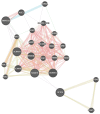ENaC gene variants and their involvement in Covid‑19 severity
- PMID: 39355526
- PMCID: PMC11443493
- DOI: 10.3892/br.2024.1864
ENaC gene variants and their involvement in Covid‑19 severity
Abstract
Epidemiological studies report the association of diverse cardiovascular conditions with coronavirus disease 2019 (COVID-19), but the causality has remained to be established. Specific genetic factors and the extent to which they can explain variation in susceptibility or severity are largely elusive. The present study aimed to evaluate the link between 32 cardio-metabolic traits and COVID-19. A total of 60 participants were enrolled, who were categorized into the following 4 groups: A control group with no COVID-19 or any other underlying pathologies, a group of patients with a certain form of dyslipidemia and predisposition to atherosclerotic disease, a COVID-19 group with mild or no symptoms and a COVID-19 group with severe symptomatology hospitalized at the Intensive Care Unit of Sotiria Hospital (Athens, Greece). Demographic, clinical and laboratory data were recorded and genetic material was isolated, followed by simultaneous analysis of the genes related to dyslipidemia using a custom-made next-generation sequencing panel. In the COVID-19 group with mild or absent symptoms, the variant c.112C>T:p.P38S was detected in the sodium channel epithelial 1 subunit α (SCNN1A) gene, with a major allele frequency (Maf) of <0.01. In the COVID-19 group with severe symptoms, the variant c.786G>A:p.T262T was detected in the SCNN1B gene, which encodes for the β-subunit of the epithelial sodium channel ENaC, with a Maf <0.01. None of the two rare variants were detected in the control or dyslipidemia groups. In conclusion, the current study suggests that ENaC variants are likely associated with genetic susceptibility to COVID-19, supporting the rationale for the risk and protective genetic factors for the morbidity and mortality of COVID-19.
Keywords: ENaC; SARS-Cov2; atherosclerosis; dyslipidemia; genetics.
Copyright: © 2024 Koniari et al.
Conflict of interest statement
The authors declare that they have no competing interests.
Figures




Similar articles
-
Genetic analysis of Rwandan patients with cystic fibrosis-like symptoms: identification of novel cystic fibrosis transmembrane conductance regulator and epithelial sodium channel gene variants.Chest. 2009 May;135(5):1233-1242. doi: 10.1378/chest.08-2246. Epub 2008 Nov 18. Chest. 2009. PMID: 19017867
-
Resequencing Epithelial Sodium Channel Genes Identifies Rare Variants Associated With Blood Pressure Salt-Sensitivity: The GenSalt Study.Am J Hypertens. 2018 Jan 12;31(2):205-211. doi: 10.1093/ajh/hpx169. Am J Hypertens. 2018. PMID: 29036630 Free PMC article. Clinical Trial.
-
Use of constant denaturant capillary electrophoresis of pooled blood samples to identify single-nucleotide polymorphisms in the genes (Scnn1a and Scnn1b) encoding the alpha and beta subunits of the epithelial sodium channel.Clin Chem. 2002 May;48(5):718-28. Clin Chem. 2002. PMID: 11978598
-
Human genetic factors associated with susceptibility to SARS-CoV-2 infection and COVID-19 disease severity.Hum Genomics. 2020 Oct 22;14(1):40. doi: 10.1186/s40246-020-00290-4. Hum Genomics. 2020. PMID: 33092637 Free PMC article. Review.
-
Host Response to SARS-CoV2 and Emerging Variants in Pre-Existing Liver and Gastrointestinal Diseases.Front Cell Infect Microbiol. 2021 Oct 25;11:753249. doi: 10.3389/fcimb.2021.753249. eCollection 2021. Front Cell Infect Microbiol. 2021. PMID: 34760721 Free PMC article. Review.
References
LinkOut - more resources
Full Text Sources
Miscellaneous
